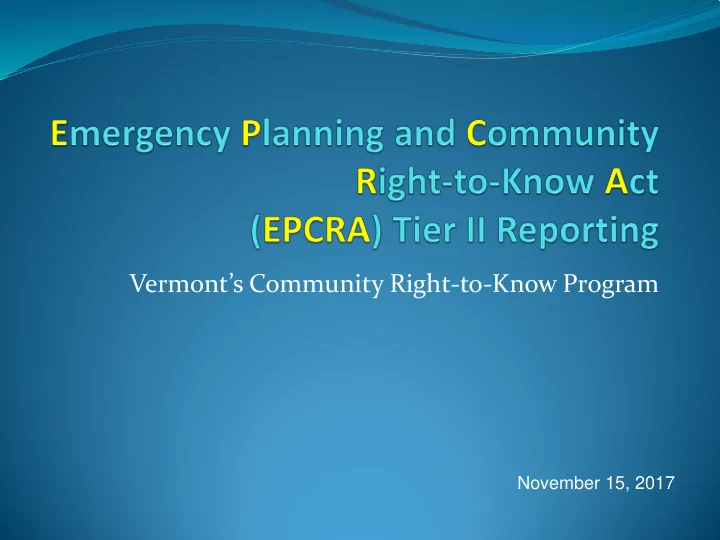

Vermont’s Community Right-to-Know Program November 15, 2017
Why EPCRA ? Key hazardous chemical releases Bhopal, India (1984) December 2-3. 1984 - Bhopal, India Union Carbide accidental release of methylisocyanate. The release killed or severely injured more than 2000 people. Institute, West Virginia (1985) August 11, 1985 - The Institute, West Virginia Union Carbide facility leaked methylene chloride and aldicarb oxime, chemicals used to manufacture the pesticide Temik; six workers were injured, and more than a hundred residents were sent to the hospital. Increased public concern What is in or around our neighborhoods Worker Right-To-Know laws OSHA Hazard Communication Standard (HAZCOM) State Right-To-Know laws Title 20 - Chapter 1
What laws establish this Program? Federal Law, 42 USC Chapter 116 Vermont Statute, 20 VSA Chapter 1 Vermont Rules and Regulations SARA Title III 42USC Chapter 116 302 11002 304 11004 311 11021 312 11022
Who May Need to Report Annually? Gasoline Stations/Auto Repair Shops Auto/Truck Dealerships Trucking Companies Warehouses Food Stores Manufacturing and Businesses Hospitals Ski Areas Motels, Hotels, and Apartment Complexes Schools and Colleges Federal, State, and Local Government Non-Profits Agriculture Drilling and Blasting companies
Are there minimum threshold reporting limits? 10,000 lbs. (approx. 1500 gallons) for petroleum products (Diesel Fuel, Gasoline, Kerosene, Propane, or #2, #4, #6 Fuel Oil, Aviation Fuel) 100 lbs for all other chemicals Explosives - any amount of Class A or B requiring license by VT Dept. of Public Safety. - 100 lbs or more - initiating explosives, blasting caps, electric blasting caps, safety fuse, fuse lighters, fuse igniters, squibs, cordeau detonant fuse, instantaneous fuse, igniter cord, igniters
Typical chemicals that a facility may need to report Any chemical that you are required to maintain an SDS on and you exceed the minimum threshold of inventory Examples but not limited to: Stockpiles of Sand – 100 lbs Road Salt – 10,000 lbs Diesel Fuel, Gasoline, Kerosene, Propane, or #2, #4, #6 Fuel Oil – 10,000 lbs Cleaning Products and Floor Waxes – 100 lbs Compressed Gases (Acetylene, Oxygen, Argon, Nitrogen, etc.) – 100 lbs Motor Oils, Hydraulic Fluids, Lubricants – 100 lbs Windshield Washer Fluids – 100 lbs Water and Wastewater Treatment Chemicals – 100 lbs Battery Acid/Lead Acid Batteries – 100 lbs Refrigerants – 100 lbs Any explosives requiring licensing by the Department of Public Safety Any amount of a carcinogenic chemical that exceeds the minimum threshold established by VOSHA
Typical chemicals that a facility may not need to report Any chemical that you have in inventory which is “Consumer Packaged” Examples but not limited to: Quart Container of Oil Road Salt – bagged 5, 10, 20 lb Fuel in cans (White Gas, Non Ethanol Gasoline, etc.) Cleaning Products and Floor Waxes – in spray containers or plastic jugs
Who manages VT EPCRA? Division of Fire Safety Tier II Reporting Facility Inspections and Identification Fee Processing SERC Administration Quarterly Meetings Membership LEPC Assistance Planning, Training, and Exercises Grants LEPC Annual $4,000 HMEP Planning and Training Grant Workshops Partner with DFS as needed for annual EPCRA Training
Where Do You Send the Tier II Reports? Reports and payment (check) sent to Department of Public Safety – Division of Fire Safety - Community Right-to Know Program, 1311 US Route 302, Suite 600, Barre VT 05641 State Emergency Response Commission (SERC) Local Emergency Planning Committee (LEPC) 13 LEPCs in Vermont Local Responding Fire Department *only SDS’s for new chemicals need to be sent w/report*
Tier II reporting information Vermont has a fee structure in place for the category of reporting for each chemical All fees are made payable to the “Department of Public Safety – HSF” Federal and State Government, municipalities, most farms, and some non-profits are exempt from paying fees on the chemicals that are reported, but still may have to file a Tier II report. Tier II reports and fees are due by March 1 st of each year for the previous calendar year’s inventory
Tier II Reporting Flowchart
Fee Structure REPORTING FEES Vermont Reporting Fees are as indicated on the fee chart listed on our website. Please follow the flow chart to determine what the respective fees will be for each of your reportable quantities of chemicals. • "Quantity Reported" is based upon the "Maximum Daily Amount (largest tank size)" of the Inventory section of the reporting form. * NEW Reporting Fees (2016) will be as follows: QTY Reported (Pounds) Fee 100-999 $40 1,000-9,999 $60 10,000-99,999 $100 100,000-999,999 $290 1,000,000 or greater $880 Any Extremely Hazardous Substance (EHS) is $250 additional for any reportable quantity.
MSDS Reporting: Hazard Category Comparison For Reporting Under Sections 311 and 312 EPA’s Hazard Categories OSHA’s Hazard Categories Fire Hazard Flammable Combustion Liquid Pyrophoric Oxidizer Explosive Compressed Gas Sudden Release of Pressure Unstable Reactive Organic Peroxide Reactive Water Reactive Immediate (Acute) Highly Toxic Toxic Irritant Sensitizer Corrosive Other hazardous chemicals with an adverse effect with short term exposure Health Hazards Delayed (Chronic) Carcinogens Health Hazard Other hazardous chemicals with an adverse effect with long term exposure * See handout for new update
Additional Tier II Information Tier II Forms/Reports are submitted to the State Emergency Response Commission (SERC), Local Emergency Planning Committee (LEPC), and your local Fire Department A program called Tier2Submit can be downloaded and installed to assist in Tier II preparation from the following website: http://www.epa.gov/emergencies/content/epcra/tier2.htm The reporting is via the Tier2Submit Software program (either attach .t2s file to email or send on CD/Thumbdrive). Latitude and Longitude are required for all reports Transportation routes are required for all reports
Vermont’s 13 LEPCs
Christopher Herrick, Deputy Commissioner Department of Public Saftey 802-241-5379 Christopher.Herrick@vermnt.gov
Recommend
More recommend